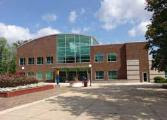
Last week, we wrote a little about what to expect with a chair massage. This week, we will describe for the beginning massage client what to expect when receiving a massage on a massage table. This applies whether you go to a licensed professional therapist or to our student clinic at CCBC.
Normally, the therapist or receptionist will have you complete a brief health questionaire. This is necessary because some of your health conditions may affect the results of a massage, or a massage may negatively affect your health when some conditions are present. For example, a blood clot is a good reason not to get a massage; if it is disturbed, it may move to the heart, lungs or brain and result in a really bad day for you family.
If you are asking for relaxation massage, you will be instructed to get on the table (see below). If you are asking for therapeutic work (normally correction for pain or restrictions in movement, among other conditions), the therapist may ask you to stand or move about a little bit to assess the way your muscles work, looking for problems. Sometimes the way we walk or stand affects conditions such as low back pain. By observing the movement, the therapist can pinpoint the particular trouble spot.
Once it's time to get on the table, the therapist will tell you how they want you positioned, face up or face down. They will then leave the room to wash their hands and arms. You will be allowed a few minutes to undress and get on the table, under the sheet. You may remove or keep on whatever clothing you wish. You will be totally covered by a sheet except for the body part that is being worked on at the moment. Most people, men and women, remove everything or all but their underpants. If you are under age 18, a parent or legal guardian will normally be required to be in the room with you during the entire massage process.
The therapist will then knock and enter the room. They may ask you about the music, room temperature and lighting. If there is anything that you don't care for, do speak up. They will then begin the massage, slowly at first. Cream or oil may be used to reduce friction and allow the therapist's hands to glide over your skin.
At the conclusion of the massage, you will be told to relax a bit, then get dressed and open the door when you are ready. The therapist may return to provide you wish some home care instruction, such as use of ice or heat, or perhaps stretching moves you may consider performing. They may also ask you about your next appointment. Be sure to take this time to ask any questions you may have about the work that was performed or the work you may be interested in.
If you have other topics you would like to read about, please write us at dwittich at ccbcmd.edu.
Doug Wittich, Adjunct Instructor
Normally, the therapist or receptionist will have you complete a brief health questionaire. This is necessary because some of your health conditions may affect the results of a massage, or a massage may negatively affect your health when some conditions are present. For example, a blood clot is a good reason not to get a massage; if it is disturbed, it may move to the heart, lungs or brain and result in a really bad day for you family.
If you are asking for relaxation massage, you will be instructed to get on the table (see below). If you are asking for therapeutic work (normally correction for pain or restrictions in movement, among other conditions), the therapist may ask you to stand or move about a little bit to assess the way your muscles work, looking for problems. Sometimes the way we walk or stand affects conditions such as low back pain. By observing the movement, the therapist can pinpoint the particular trouble spot.
Once it's time to get on the table, the therapist will tell you how they want you positioned, face up or face down. They will then leave the room to wash their hands and arms. You will be allowed a few minutes to undress and get on the table, under the sheet. You may remove or keep on whatever clothing you wish. You will be totally covered by a sheet except for the body part that is being worked on at the moment. Most people, men and women, remove everything or all but their underpants. If you are under age 18, a parent or legal guardian will normally be required to be in the room with you during the entire massage process.
The therapist will then knock and enter the room. They may ask you about the music, room temperature and lighting. If there is anything that you don't care for, do speak up. They will then begin the massage, slowly at first. Cream or oil may be used to reduce friction and allow the therapist's hands to glide over your skin.
At the conclusion of the massage, you will be told to relax a bit, then get dressed and open the door when you are ready. The therapist may return to provide you wish some home care instruction, such as use of ice or heat, or perhaps stretching moves you may consider performing. They may also ask you about your next appointment. Be sure to take this time to ask any questions you may have about the work that was performed or the work you may be interested in.
If you have other topics you would like to read about, please write us at dwittich at ccbcmd.edu.
Doug Wittich, Adjunct Instructor






